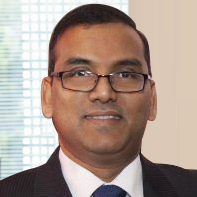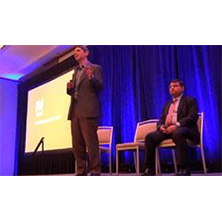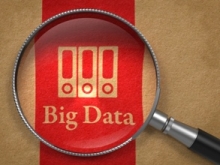In March of this year Martin Chavez, CIO at Goldman Sachs, sat down to explain paradigm shifts in technology and the business world.
He started the roughly 5 minute conversation by explaining matter-of-factly that “every 20 years, in the software business, there is a paradigm shift.” This notion creates quite a stir for the business world, as companies must learn to adapt and grow with these new ways of doing work, and creating information.
Here is a rough timeline of the last 40 years (as described by Chavez):
40 years ago:
Computers begin to be used for business. If you want the massive machine (often occupying an entire room) to do something for you, you must walk to the room that houses the mainframe, create a punch sheet, and manually insert it. After the punch sheet method comes the ability to type programs directly into the system, only slightly improving the process.
20 years ago:
Personal Computing debuts. Office desks are adorned with desktop units for each employee, and consumers begin to buy the devices for their home. These smaller, more agile computers are connected to larger servers; in the case of offices, these are still located in a room dedicated to housing the technology.
Recent years:
Personal computing has abandoned the bulky server housing system, storing our information in servers, but replacing in-house hardware with the cloud.
The most recent paradigm shift—outside of introducing mobile computing, and changing the way we communicate—has drastically changed the way businesses progress through early stages, to profitability. Chavez explains that throughout most of the computing era it has taken approximately $50 Million (USD) in investments to bring a company through adolescence and into the green. However, during the latest shift, we have witnessed an unprecedented drop in that number to (Chavez estimates) about $5 Million (USD). He goes on to emphasize, “ This is the most powerful price-dropping or deflationary phenomenon that any of us has ever seen.”
What happened?
$45 Million dollars isn’t a small chunk of change. A drop in average investment cost of this magnitude signals a change in the entire culture of starting a business. This shift to cloud computing has removed the necessity of companies to invest in hardware; they aren’t buying servers, switches, networks, and fiber optics. They’re paying a monthly fee to house their storage offsite, and access it anywhere in the world.
What’s more, is that businesses aren’t shy to start keeping even less of their computing in house- extending use of this new methodology to software; through open source.
Open source, in its purest form, is free, extremely high-quality software created, uploaded, and maintained by thousands of engineers all over the world. These programs are being refined, and re-worked by a tight-knit community of open source specialized developers every day, and because of that users are getting the most sophisticated versions of programs-for free.
So what does this all mean?
There are a lot of inferences that can be drawn about the future of fluid business. Though these are all hypothesis, we do know that physical offices and hardware are rapidly becoming a thing of the past.
Solution providers—companies that specialize in off-site engineering, development, and maintenance—are already beginning to capture the market. With the ability to effectively lower overhead costs, for new businesses and old alike, solution providers are riding this paradigm shift, and changing the way business gets done. Companies no longer have to reach out to several different companies to solve their problems; they have one number, one single point of contact for all of their technology (an in some case marketing) needs. When a cost effective and space saving option like this exists, how can we expect executives to cling to the “old way” of doing things?
There is no way of predicting the future of business in the digital age, but we can take note from emerging patterns, and try our best to stay ahead of the curve. With the rise of solution providers there will be a dramatic shift in office culture and the nature of software all together. While we wait to see what happens, there are some questions we can think about:
- How can we take these new methods of doing business and put them to use?
- What will these changes mean for my clients?
- What does this most recent paradigm shift mean for me?
Special thanks to Goldman Sachs and Martin Chavez for posting such an informative video.

Balaji has spent over 18 years in the IT Services Industry. With an experience encompassing Services and Product Marketing, he has successfully managed globally distributed Marketing and Product teams. He’s an analytical marketer with strong understanding and experience across marketing strategy, demand generation, field marketing, technology partner marketing, account based marketing, digital marketing, event management, analysis and third party relationship, PR/Media, people management, etc.








